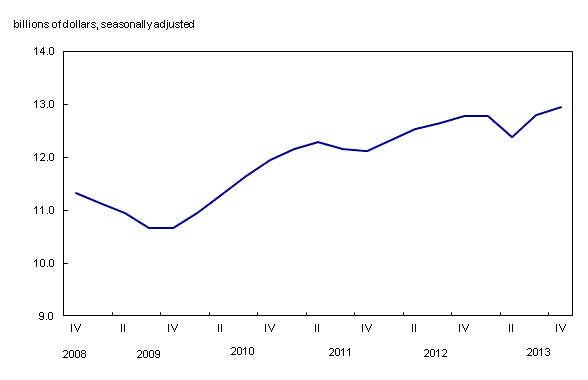Investment in non-residential building construction, fourth quarter 2013
Archived Content
Information identified as archived is provided for reference, research or recordkeeping purposes. It is not subject to the Government of Canada Web Standards and has not been altered or updated since it was archived. Please "contact us" to request a format other than those available.
Released: 2014-01-17
Investment in non-residential building construction reached $12.9 billion in the fourth quarter, up 1.1% from the previous quarter. It was the second consecutive quarterly increase and was led by higher spending on commercial building construction.
Overall, total investment rose in six provinces in the fourth quarter, with the largest gains occurring in Alberta and Quebec. The increase in Alberta was spread across the commercial, industrial and institutional components, while in Quebec, the gain was in the institutional and commercial components.
In Ontario, the rise in the commercial component was not enough to offset declines in the institutional and industrial components.
Census metropolitan areas
Investment was up in 18 of the 34 census metropolitan areas. The largest increases were in Edmonton and Montréal.
In Edmonton, the gain was mostly attributable to commercial investment, while in Montréal, it came from higher construction spending for institutional and commercial buildings.
London and Sherbrooke posted the largest declines, mostly as a result of decreases in the institutional and commercial components.
Commercial component
Investment in commercial building construction reached $7.8 billion in the fourth quarter, up 1.7% from the previous quarter. This was the second consecutive quarterly increase and reflected higher spending in the construction of office and recreational buildings as well as retail and wholesale outlets in several provinces.
The largest contribution in the commercial component came from Alberta, where investment rose 4.9% to $1.8 billion. The increase resulted from rising investment among several categories of commercial buildings.
Investment in Ontario increased 1.9% to $2.9 billion, mostly attributable to higher spending for recreational and office buildings.
Newfoundland and Labrador posted the largest decline, as a result of lower spending spread among several commercial building categories.
Institutional component
In the institutional component, investment increased 0.3% to $3.4 billion, the second straight quarterly gain. Institutional investment rose in eight provinces.
The largest increases occurred in Quebec and Alberta. In Quebec, spending was up 4.4% to $754 million, reflecting a rise in investment in health care facilities and other government buildings. In Alberta, investment rose 4.2% to $405 million, the sixth consecutive quarterly gain for the province. The advance was led by higher spending in the construction of health care facilities.
The only declines occurred in Ontario and Newfoundland and Labrador. In Ontario, institutional investment fell 5.0% to $1.3 billion, mostly as a result of lower spending for educational buildings.
In Newfoundland and Labrador, investment declined for the eighth consecutive quarter, falling 5.2% to $23 million. The decrease was mostly the result of lower spending on the construction of nursing home buildings.
Industrial component
Investment in industrial projects rose 0.3% to $1.8 billion in the fourth quarter, the second consecutive quarterly gain. Growth in this component was mainly from the construction of primary industry buildings and manufacturing plants in six provinces.
Provincially, the largest increase was in Alberta, where investment rose 4.7% to $423 million. Most of the gain was attributable to manufacturing plants.
British Columbia and Ontario posted the largest declines in the fourth quarter. British Columbia saw industrial investment decline 5.2% to $174 million, mostly because of lower construction of manufacturing plants. In Ontario, industrial investment decreased 1.5% to $597 million, mainly because of lower spending on utility buildings and manufacturing plants.
Note to readers
Unless otherwise stated, this release presents seasonally adjusted data expressed in current dollars, which facilitates comparisons by removing the effects of seasonal variations. For more information on seasonal adjustment, see Seasonal adjustment and identifying economic trends.
Investments in non-residential building construction exclude engineering construction (such as for highways, sewers, bridges and oil and gas pipelines). This series is based on the Building Permits Survey of municipalities, which collects information on construction intentions.
Work put-in-place patterns are assigned to each type of structure (industrial, commercial and institutional). These work patterns are used to distribute the value of building permits according to project length. Work put-in-place patterns differ according to the value of the construction project; a project worth several million dollars will usually take longer to complete than will a project of a few hundred thousand dollars.
Additional data from the Capital and Repair Expenditures Survey are used to create this investment series. Investments in non-residential building data are benchmarked to Statistics Canada's System of National Accounts' non-residential building investment series.
For the purpose of this release, the census metropolitan area of Ottawa–Gatineau (Ontario/Quebec) is divided into two areas: the Ottawa part and the Gatineau part.
Contact information
For more information, or to enquire about the concepts, methods or data quality of this release, contact us (toll-free 1-800-263-1136; 514-283-8300; infostats@statcan.gc.ca).
To enquire about the concepts, methods or data quality of this release, contact Mahamat Hamit-Haggar (613-951-0862), Investment, Science and Technology Division.
- Date modified:



